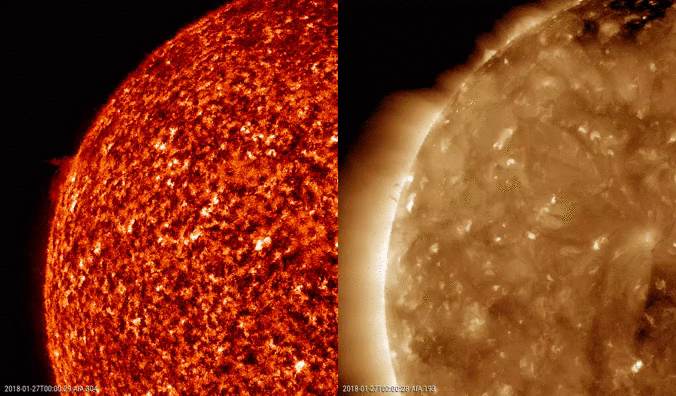Solar activity was again very low. Fortunately, at the end of the week, some interesting prominences appeared at the solar limb. Prominences are relatively cool and dense structures reaching all the way up into the corona (the Sun's hot outer atmosphere). They are clouds of ionized gas above the solar surface squeezed between magnetic regions of opposite polarity. In dedicated filters such as Hydrogen-alpha (H-alpha, 656.3 nm or in EUV (extreme ultraviolet) such as observed by SDO/AIA 304, they appear as bright structures hovering over the solar limb, and as dark line-shaped features on the solar disk where they are called filaments. The imagery underneath (AIA 304) shows the most significant prominences near the northeast and especially the northwest limb on 27 January.

In AIA 304, we observe solar plasma (charged particles) at a temperature of about 80,000 degrees. The plasma in the higher chromosphere and lower transition region emits at this wavelength. This temperature is higher than that of the plasma seen in Hydrogen-alpha (H-alpha, 656.3 nm; about 10,000 degrees), but much cooler than most of the other extreme ultraviolet (EUV) filters of SDO, such as AIA 193 (about 1.3 million degrees). Hence, these "cool" prominences seen in 30.4 nm (left image underneath) are usually somewhat beefed up compared to H-alpha, whereas they are hardly visible in the "hotter" SDO filters such as AIA 193 (right image underneath). There, if visible at all, they are mostly observed as dark features against the brighter coronal background. Over three days (from 27 to 29 January), the AIA 304 images clearly show how the prominence chunks gradually interact more with each other, performing a lovely dance as they get connected to each other by a plasma bridge. In AIA 193, the already barely visible densest parts of the structures gradually fade from view.

At the northeast limb, a smaller and less dynamic prominence becomes visible during this period. It is denser than its northwestern counterpart, and hence better visible against the bright coronal background in AIA 193. Interestingly, in AIA 193, one can see a semi-circular structure around this prominence (see imagery underneath). This is called a coronal prominence cavity. Prominences are often seen to be associated with these coronal cavities. Cavities are the upper parts of the filament channels. They appear darker than the surrounding corona, because there are 30-50% less particles present. They are also higher than the prominences. Because the outlook of the whole structure resembles somewhat the three-part structure of a coronal mass ejection (CME; see e.g. this news item), and because many have actually been observed erupting into a CME, coronal cavities are still a major field of research.

Further readings and examples are in this STCE news item, A Hitchhiker's Guide to Space and Plasma Physics, this NASA news item, and in this dissertation (Panesar and Navdeep Kaur, 2014).





